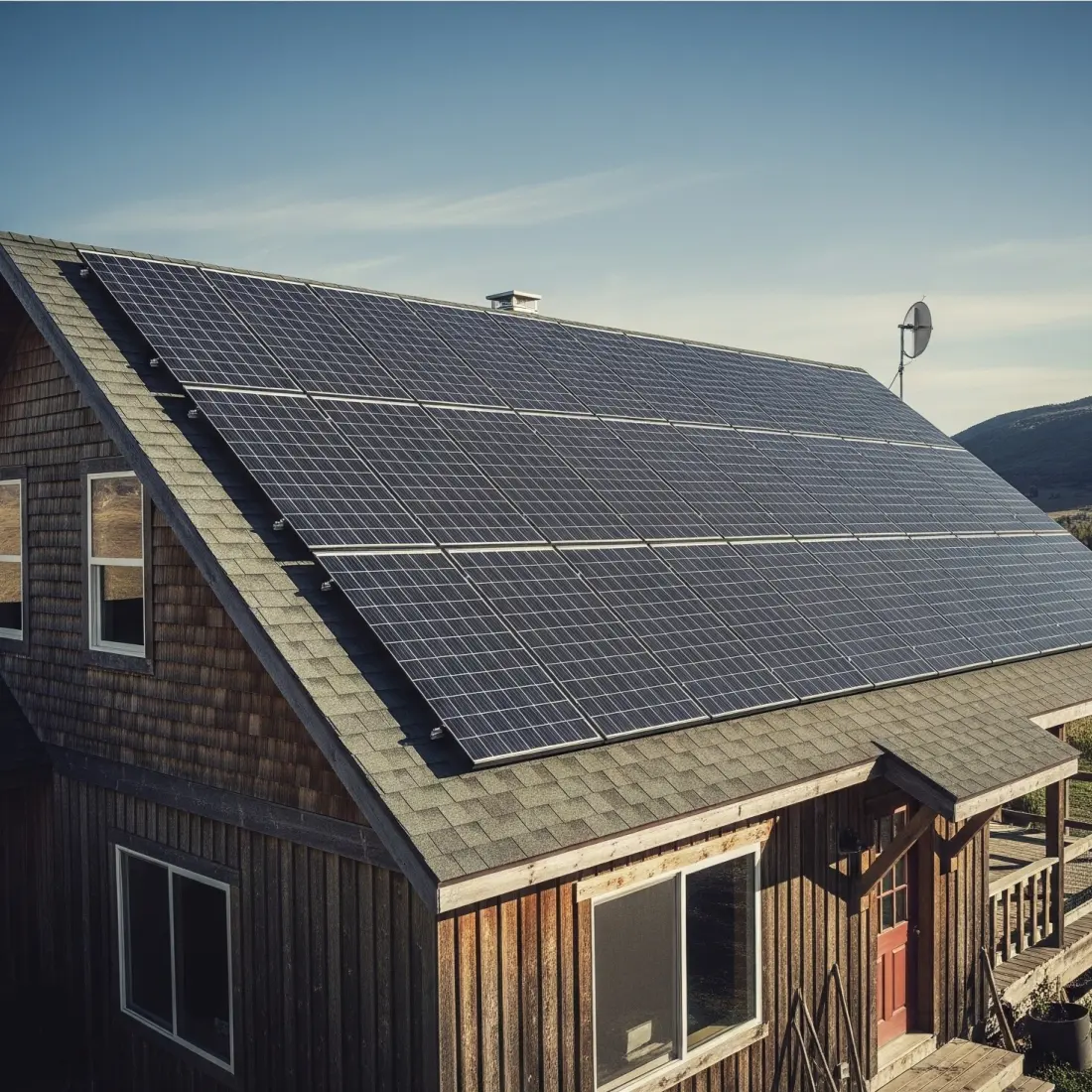What is an off-grid solar power system?


An off-grid solar system is an energy solution that doesn’t rely on a traditional electricity grid. Unlike grid-tied systems, they don’t have a grid to use as a backup. However, they provide energy autonomy and resilience during outages.
According to a report by the Global Off-Grid Lightning Association, off-grid solar system sales increased by 17% in the first half of 2024, highlighting their growing role in global energy access.
This article will explore the concept of an off-grid solar power system and how it differs from a grid-tied solution.
What is an off-grid solar system and how does it work?
An off-grid solar system is a solar power system that operates without the support of the local utility grid. Instead, it relies on batteries to store electricity for later use. The infographic below shows how off-grid solar power systems work.
Off-grid solar systems generate electricity using solar panels and charge the battery using a charge controller. The inverter then converts the electricity to power the household or a larger-scale infrastructure.
Off-grid solar power system components
An off-grid solar power system comprises essential components that capture, store, and distribute solar energy. These include solar panels, a charge controller, batteries, and an inverter.
Solar panels
Solar panels, also called photovoltaic (PV) panels, are the central component of any solar power system. They capture sunlight and convert it into direct current (DC) electricity. In an off-grid system, this electricity can be used immediately or stored in batteries for later use.
There are a few types of solar panels that can be used for off-grid solar systems, depending on your personal efficiency needs and budget:
Monocrystalline – highest-efficiency panels made from a single silicon crystal.
Polycrystalline – a multiple silicon crystal panel that’s more budget-friendly but less efficient than monocrystalline panels.
Thin-film – less efficient panels that are used more for large-scale installations.
You can also either ground-mount or roof-mount the system depending on the available space and sunlight exposure. Ground-mounted systems are usually more suitable for properties with ample space, while roof-mounted systems are better for smaller properties or those with limited space.
Charge controller
A charge controller regulates the flow of electricity from solar panels to batteries. It controls the rate at which electric current is added to or drawn from the batteries to avoid overcharging. This helps extend the battery life and ensure the overall efficiency and safety of the off-the-grid solar system.
Batteries
Batteries are essential components in off-grid solar systems as they store excess energy generated by the solar panels. The stored energy can be leveraged in periods of limited sunlight, ensuring a continuous power supply. There are a few types of batteries that can be used in an off-grid solar system:
Lithium batteries – battery type that can be stored without ventilation, are safe to use, low maintenance, and have a long lifespan. These advantages make lithium batteries a popular choice for off-grid solar systems.
Flooded lead acid batteries – a type of lead acid battery that requires maintenance, including water level checking. However, it’s a more budget-friendly solution than lithium batteries.
AGM lead acid batteries – lead acid battery type that doesn’t require maintenance but offers a shorter lifespan than lithium batteries. It’s usually more expensive than flooded batteries but still cheaper than lithium.
Ultimately, the best battery will depend on your energy needs and budget. While lead-acid batteries are cheaper, lithium batteries can be more cost-effective in the long run.
Inverter
The inverter is responsible for converting the stored DC power from the batteries into alternating current (AC) power used by most household appliances. It does this by changing the frequency and voltage of the electricity, making it compatible with standard household outlets.
Off-grid vs. grid-tied solar power systems
An off-grid solar power system operates independently from the local utility grid. It generates power directly from the sun, stores it in batteries, and uses it when required. In contrast, a grid-tied solar power system maintains a connection to the local utility grid and can draw power from it when necessary.
Although both systems have their upsides and downsides, the best choice for you will depend on your needs, location, and budget. Here are the main differences between an off-grid and grid-tied system:
Now, let’s explore the upsides of both solutions in more detail.
Off-grid solar system advantages
As independent solutions, off-grid solar systems come with multiple advantages:
Users have complete control over their power source.
Since you generate and consume generated power, you’re not subject to fluctuating energy prices or monthly bills.
It’s a powerful solution for remote areas with unreliable electricity.
With proper system sizing and battery storage, you can have reliable power even during periods of low sunlight.
That said, off-grid solar systems have some disadvantages. For example, they generate higher initial costs due to the reliance on batteries. Additionally, the produced energy that isn’t used up can go to waste.
Grid-tied solar system advantages
While a grid-tied system is dependent on the grid, it has a few key advantages:
Grid-tied systems typically cost less because they don’t require expensive battery storage.
Excess power is sold back to the grid, offsetting your electricity costs.
You’ll always have access to power, even if your solar system isn’t producing enough to meet your needs.
Unlike off-grid solar systems, a grid-tied solution also has its downsides. For example, it doesn’t provide a backup option if the grid is shut down.
How to decide the appropriate size for an off-grid solar system
To calculate an off-grid solar power system’s size, you need to establish your energy needs, location, and budget. Let’s take a look at the main steps to decide the right off-grid system size for you:
1️⃣ Determine daily kilowatt-hour (kWh) energy requirements. This can be calculated by adding up the wattage of all appliances you use and the average usage duration.
2️⃣ Divide daily energy requirements by the peak sun hours in your location to get the kW output you need from your solar panels. A helpful rule of thumb is to opt for a 12V system if your energy needs are less than 1,000 watts or a larger system if your usage is between 1,000 and 3,000 watts.
3️⃣ Determine your budget. While larger systems can generate more power, they come with higher upfront costs. It’s crucial to balance your energy needs with what you can afford. You can use tools like the PVcase Yield calculator to help determine the best system size for your needs.
How much do off-grid solar systems cost?
Investing in off-grid solar systems can involve higher initial equipment and installation costs, as well as ongoing expenses, like battery or solar panel maintenance. However, it can be a financially viable option in the long run. These systems can reduce or even eliminate electricity bills, and the savings over time can offset the initial investment.
Additionally, many governments and organizations offer incentives and rebates for adopting solar energy, reducing the cost of going off-grid. With growing societal, economic, and environmental pressures for businesses to adopt solar, investing in renewable energy sources like solar can also enhance a company’s image and reputation.
To give you a clearer picture, here’s a breakdown of estimated off-grid solar power system costs:
At least $5,000 for a 10 kW array or panels
At least $4,000 for an inverter and built-in charge controller
At least $20,000 for a 20 kWh battery system
Anywhere from $3,200 to $4,600 for installation and labor costs (about 7% of the total price)
There may be additional costs related to engineering, logistics, and other overhead expenses, which can account for 40% of project costs. Ultimately, the total price for an off-grid system can range anywhere from $45,000 to $65,000.
Consider your needs and budget, research, and take advantage of available resources to switch to an off-grid solar system.